| January 1, 2007
Audiophile Discs from Norway
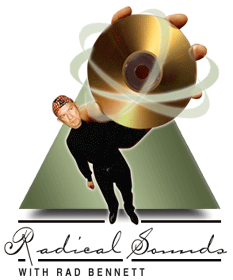 I listen to many discs, but most
don’t pass muster for this column or inspire a second hearing. Rarely, I put
something in the player with no expectations and hear sounds that freeze me into listening
mode, unable to tear myself away. This happened recently. One of the SoundStage!
reviewers had sent me a solo piano disc of holiday variations on the 2L label and turned
me on to a review of some Mozart violin concertos from the label. Always looking for the
best in sound, I wrote 2L and received a half dozen discs for my effort. I listen to many discs, but most
don’t pass muster for this column or inspire a second hearing. Rarely, I put
something in the player with no expectations and hear sounds that freeze me into listening
mode, unable to tear myself away. This happened recently. One of the SoundStage!
reviewers had sent me a solo piano disc of holiday variations on the 2L label and turned
me on to a review of some Mozart violin concertos from the label. Always looking for the
best in sound, I wrote 2L and received a half dozen discs for my effort.
The one that caught my attention is Over the Hills --
and Far Away, a collection of marches performed by the Kristiansand Wind Ensemble
conducted by Bjørn Sagstad. Every once in a while, I go over to Shepherdstown, West
Virginia, to hear the local university’s wind ensemble, and Over the Hills
sounded exactly like one of those concerts. It is one of the most realistic recordings of
a band I’ve ever heard. The woodwinds are up front, the brass behind, and the
percussion behind the brass. Just listen to the opening of Saint-Saëns’ Marche
Militaire Française, which begins this hybrid multichannel SACD. In the theme
statement, you first hear the horns, center stage and back, then the first trumpet and
orchestral bells, so clean you can follow each line.
It wasn’t just the sound that was wonderful. The
Kristiansand Wind Ensemble is superb, and Bjørn Sagstad a first-rate leader. Though the
marches range from the jolly title tune to Mendelssohn’s somber Trauer-Marsch,
each has a singular rhythmic vitality, and every interpretation sounds just right. What
more can you ask? That combination of great performances in great sound doesn’t come
along every day.
I’m now busy exploring the rest of the 2L catalog,
which includes a lot of music by 20th-century Norwegian composers as well as older
favorites. If you want the best in multichannel sound, I suggest you do the same.
Here’s the link: www.2l.no. I hope to hear new releases as they come out, and will
keep you posted.
In the meantime, here are six significant and enjoyable
discs to bring in the New Year.
Richard Strauss: Four Last Songs; Death
and Transfiguration
Wagner: Prelude and Liebestod from "Tristan und Isolde"
Christine Brewer, soprano; Donald Runnicles, Atlanta Symphony.
Telarc SACD-60661, Hybrid Multichannel SACD.
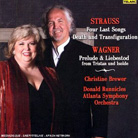 Christine Brewer’s voice
is one of the wonders of the vocal and opera worlds. Warm, big, voluptuous, yet precisely
focused, it’s as close to a perfect vocal instrument as one can get. Better yet,
Brewer knows how to use it. Her singing of Isolde’s Liebestod is absorbing and
appealing, with just the right amount of drama balanced with just the right amount of
romantic passion. In this recording, her reaches for high notes were so lovely and true
they sent shivers down my spine. I had that feeling, as well as goose bumps all over, when
conductor Donald Runnicles’ performance of Death and Transfiguration reached
the "redemption" climax near the end of the piece. I have never heard it done so
passionately yet so naturally. Runnicles just lets it unfold, which proves the right thing
to do. In the rest of the work, he juggles drama and lush romanticism with ease. The
Atlanta musicians prove again that they play in one of the world’s great orchestras.
Telarc’s sound is rich and full, with generous yet not overbearing reverb in the
surrounds and a perfect balance of soloist and orchestra. Having a breakneck October
schedule, I almost passed this SACD by; I’m very happy I did not. Once I’d
pushed Play and heard the first few measures, hell or high water couldn’t have moved
me from my listening seat. I’m up for more Strauss from Runnicles and the Atlanta
Symphony. Christine Brewer’s voice
is one of the wonders of the vocal and opera worlds. Warm, big, voluptuous, yet precisely
focused, it’s as close to a perfect vocal instrument as one can get. Better yet,
Brewer knows how to use it. Her singing of Isolde’s Liebestod is absorbing and
appealing, with just the right amount of drama balanced with just the right amount of
romantic passion. In this recording, her reaches for high notes were so lovely and true
they sent shivers down my spine. I had that feeling, as well as goose bumps all over, when
conductor Donald Runnicles’ performance of Death and Transfiguration reached
the "redemption" climax near the end of the piece. I have never heard it done so
passionately yet so naturally. Runnicles just lets it unfold, which proves the right thing
to do. In the rest of the work, he juggles drama and lush romanticism with ease. The
Atlanta musicians prove again that they play in one of the world’s great orchestras.
Telarc’s sound is rich and full, with generous yet not overbearing reverb in the
surrounds and a perfect balance of soloist and orchestra. Having a breakneck October
schedule, I almost passed this SACD by; I’m very happy I did not. Once I’d
pushed Play and heard the first few measures, hell or high water couldn’t have moved
me from my listening seat. I’m up for more Strauss from Runnicles and the Atlanta
Symphony.
Mahler: Symphony No.2, "Resurrection"
Lisa Milne, soprano; Birgit Remmert, contralto; Iván Fischer, Hungarian Radio Choir,
Budapest Festival Orchestra.
Channel Classics CCS SA 23506, Hybrid Multichannel SACD.
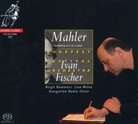 Mahler’s gigantic second symphony,
scored for soloists, chorus, and a huge orchestra -- including extra brass, an offstage
band, two harps, and organ -- is a natural for high-resolution audio formats. Ranging from
the softest whisper to thundering fortissimos, it will test any audio system to the
max. There have already been hi-rez recordings led by Maurice Abravanel, Zubin Mehta,
Michael Tilson Thomas, Leonard Slatkin, and Riccardo Chailly, but all of them seem only
warmups for this release. Iván Fischer has ideal soloists, and a chorus and orchestra
that surpass all the others in technical ability and ravishing tone. His pacing is just
right and his control of dynamics remarkable. The first entrance of the chorus is pianissimo
in other readings; here it seems whispered, a thought carried on a gentle breeze. Yet when
the big finale comes, Fischer pulls out all the stops. In most performances, the
orchestral coda after the chorus stops singing sounds like an afterthought; not so here.
The sound is, for my money, perfect. All balances are ideal. For once, the offstage
instruments sound offstage, not merely softer. The organ thunders in the finale without
overpowering the orchestra, and the two vocal soloists are heard in proper balance with
the orchestra and chorus. The two-channel tracks sound excellent -- until you hear the
multichannel ones. Mahler’s gigantic second symphony,
scored for soloists, chorus, and a huge orchestra -- including extra brass, an offstage
band, two harps, and organ -- is a natural for high-resolution audio formats. Ranging from
the softest whisper to thundering fortissimos, it will test any audio system to the
max. There have already been hi-rez recordings led by Maurice Abravanel, Zubin Mehta,
Michael Tilson Thomas, Leonard Slatkin, and Riccardo Chailly, but all of them seem only
warmups for this release. Iván Fischer has ideal soloists, and a chorus and orchestra
that surpass all the others in technical ability and ravishing tone. His pacing is just
right and his control of dynamics remarkable. The first entrance of the chorus is pianissimo
in other readings; here it seems whispered, a thought carried on a gentle breeze. Yet when
the big finale comes, Fischer pulls out all the stops. In most performances, the
orchestral coda after the chorus stops singing sounds like an afterthought; not so here.
The sound is, for my money, perfect. All balances are ideal. For once, the offstage
instruments sound offstage, not merely softer. The organ thunders in the finale without
overpowering the orchestra, and the two vocal soloists are heard in proper balance with
the orchestra and chorus. The two-channel tracks sound excellent -- until you hear the
multichannel ones.
Beck: Symphonies, Op.4, Nos.1-3; Overture from
"L’isle déserte"
Michael Schneider, La Stagione Frankfurt.
CPO 777 033, two Hybrid Multichannel SACDs.
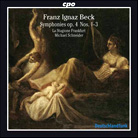 Franz Ignaz Beck’s long life
(1734-1809) paralleled Haydn’s (1732-1809), but Beck never received anything like the
level of acclaim his compatriot enjoyed. Hearing these vigorous works, composed in 1766,
the reason for the discrepancy is hard to fathom. They have the swagger of a young man,
yet in the middle movements a gentleness that can come only with experience and age. The
oboes and horns are often featured, and the symphonies are scored for continuo, a
carryover from the Baroque period. La Stagione Frankfurt, a largish chamber orchestra
founded in 1988, has specialized in Beck’s music, and its accomplished players show
great enthusiasm for this vibrant music, performing with vigor but without ever coarsening
the music. The sound is close-up with lots of detail, but never at the expense of an aural
picture of the entire ensemble. The small number of strings allows the all-important oboes
and horns to be heard with ease. The two-channel tracks are fine, but the surround mixes
bring the listener a little closer to the ensemble and allow it to sound more three
dimensional. Franz Ignaz Beck’s long life
(1734-1809) paralleled Haydn’s (1732-1809), but Beck never received anything like the
level of acclaim his compatriot enjoyed. Hearing these vigorous works, composed in 1766,
the reason for the discrepancy is hard to fathom. They have the swagger of a young man,
yet in the middle movements a gentleness that can come only with experience and age. The
oboes and horns are often featured, and the symphonies are scored for continuo, a
carryover from the Baroque period. La Stagione Frankfurt, a largish chamber orchestra
founded in 1988, has specialized in Beck’s music, and its accomplished players show
great enthusiasm for this vibrant music, performing with vigor but without ever coarsening
the music. The sound is close-up with lots of detail, but never at the expense of an aural
picture of the entire ensemble. The small number of strings allows the all-important oboes
and horns to be heard with ease. The two-channel tracks are fine, but the surround mixes
bring the listener a little closer to the ensemble and allow it to sound more three
dimensional.
Howard Shore: The Lord of the Rings: The Two
Towers -- The Complete Recordings
Howard Shore, London Philharmonic Orchestra, chorus, soloists, etc.
Reprise 44376-2, three CDs, one DVD-Audio containing 5.1 and 2.0 high-resolution mixes.
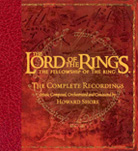 Last year, Reprise gave us a similar set
-- three CDs, one DVD-A -- for the music of The Fellowship of the Ring, the first
film in The Lord of the Rings trilogy. Presumably next fall we’ll get
the complete music for The Return of the King. This second of the three is packaged
exactly like last year’s offering, which is a shame. The box contains a sturdy
foldout that contains three CDs, plus a handsome booklet that explains the use of themes
and discusses the score in depth. The DVD-A includes, in multichannel sound, all the
tracks that are on the three CDs. It’s secured to the inside of the box lid by a
rubber hub that’s none too steady: when you open the box, the naked DVD is on the
left, on the lid’s inside surface, while the CDs and booklet are in a protective
inner folder. If you don’t put the disc back on the hub just right, it falls off when
you close the lid. Like many other buyers, I complained about this when the Fellowship
set was released (read the reviews at Amazon.com). But apparently the DVD-A, despite being
labeled "Entire Score in Superior Sound," is regarded by Reprise as a stepchild
unworthy of even modest consideration. Moreover, there’s no track printout for the
DVD-A; you’re supposed to get that from the video menu. That’s fine if you use a
screen, but many of us listen to DVD-As in systems that lack displays. In addition, the
booklet discusses character themes, and gives examples by citing CD disc numbers and
tracks that will mean nothing to the DVD-A listener. Last year, Reprise gave us a similar set
-- three CDs, one DVD-A -- for the music of The Fellowship of the Ring, the first
film in The Lord of the Rings trilogy. Presumably next fall we’ll get
the complete music for The Return of the King. This second of the three is packaged
exactly like last year’s offering, which is a shame. The box contains a sturdy
foldout that contains three CDs, plus a handsome booklet that explains the use of themes
and discusses the score in depth. The DVD-A includes, in multichannel sound, all the
tracks that are on the three CDs. It’s secured to the inside of the box lid by a
rubber hub that’s none too steady: when you open the box, the naked DVD is on the
left, on the lid’s inside surface, while the CDs and booklet are in a protective
inner folder. If you don’t put the disc back on the hub just right, it falls off when
you close the lid. Like many other buyers, I complained about this when the Fellowship
set was released (read the reviews at Amazon.com). But apparently the DVD-A, despite being
labeled "Entire Score in Superior Sound," is regarded by Reprise as a stepchild
unworthy of even modest consideration. Moreover, there’s no track printout for the
DVD-A; you’re supposed to get that from the video menu. That’s fine if you use a
screen, but many of us listen to DVD-As in systems that lack displays. In addition, the
booklet discusses character themes, and gives examples by citing CD disc numbers and
tracks that will mean nothing to the DVD-A listener.
That rant aside, this DVD-A sounds as magnificent as the
first one did. The bass is solid, the highs are sweet and transparent, the stage is deep,
and the presence is palpable. The percussion and brass sound particularly rich, and all
the participants -- chorus, orchestra, and soloists -- are ideally balanced. The rear
channels are used for ambience and to better shape the front channels. The DVD-A is a disc
worth treasuring, so be careful when you close that lid.
Puccini: Tosca
Montserrat Caballé, José Carreras, Ingvar Wixell; Sir Colin Davis, Royal Opera House
Chorus & Orchestra.
PentaTone 5186 147, two Hybrid Multichannel SACDs.
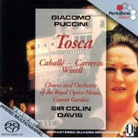 Recorded in 1976, this is a Tosca with
many strengths. Its three principal singers were all at the top of their game and sound
solid and sonorous from beginning to the end. Sir Colin Davis, not usually associated with
Puccini, brought to his interpretation the same sort of objective rapture that he has
often lavished on the works of Berlioz. This is an arch-romantic reading, but one tempered
with intelligence and logic. The performance, originally intended to be released in a
Quadraphonic mix, was recorded on eight tracks in order to achieve the best balance of
singers and orchestra. The Quad mix was never made, however, so this new mix from the
eight-track master is the first surround version. Recorded in 1976, this is a Tosca with
many strengths. Its three principal singers were all at the top of their game and sound
solid and sonorous from beginning to the end. Sir Colin Davis, not usually associated with
Puccini, brought to his interpretation the same sort of objective rapture that he has
often lavished on the works of Berlioz. This is an arch-romantic reading, but one tempered
with intelligence and logic. The performance, originally intended to be released in a
Quadraphonic mix, was recorded on eight tracks in order to achieve the best balance of
singers and orchestra. The Quad mix was never made, however, so this new mix from the
eight-track master is the first surround version.
It is a very successful one. The singers move naturally
about the wide, deep soundstage in perfect balance with the orchestra. The overall sound
is warm and lush, yet clean enough to let minute details clearly emerge. The surround
channels are largely used for ambience, though Act II’s offstage chorus, with Tosca
singing the lead, is successfully wrapped around the rear stage. I had thought perhaps the
same would be done with other offstage effects, but while these really do sound offstage,
they’re confined to the front. Perhaps they were buried in that eight-track mix, but
the cannon fire in Act I and the shots of the firing squad in Act III seem to have
disappeared -- a small criticism of a production that otherwise is artistically and
sonically first rate. You seldom hear an opera recording with so impeccable a balance of
voices and orchestra. I’m told that this is the only opera recording that Philips
considered for Quad treatment. As good as it is, that’s too bad.
Steve March Tormé: Tormé Sings Tormé
AIX 83042, DVD and DualDisc. Contains Dolby Digital 5.1, MLP high-resolution 5.1, and PCM
24-bit/96kHz mixes.
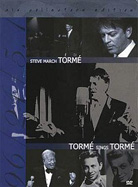 Steve March Tormé is the son of Mel
Tormé. He grew up, however, with his stepdad, Hal March, the famous game-show host. In
the 1970s, under the name Steve March, he released an LP, Lucky. Though Lucky
was in more of a pop-rock vein than the music of March’s father, critics loved it and
found it promising. About 15 years before Mel’s death, Steve got to know him better.
He learned to sing jazz as Mel had and put out several exciting CDs on the Frozen Rope
label, one of which includes a dynamic father-son duet. Now here is his latest, a
DVD-Audio recording of songs in Mel’s style. It’s appealing from beginning to
end, as March Tormé sails through such upbeat numbers as "Sweet Georgia Brown,"
which has some amazing scat singing near the end, and croons slower ballads, such as
"The Folks Who Live on the Hill." He’s in superb voice in both veins, and
is backed by ten first-rate musicians who remind me of the Marty Paich Dektette. Producer
Mark Waldrep has recorded everyone in MLP lossless sound that is the next best thing to
being there. As usual with AIX releases, there are many extras, including the complete
sessions in widescreen video and Dolby Digital 5.1 sound, as well as rare footage of Mel
Tormé onstage and in interview. You can spend a lot of quality time listening and viewing
the first three sides of the set, then take the CD side with you in the car -- or, as I
did, rip it to your iPod for on-the-go enjoyment. Overall, this is a most successful
effort. Steve March Tormé is the son of Mel
Tormé. He grew up, however, with his stepdad, Hal March, the famous game-show host. In
the 1970s, under the name Steve March, he released an LP, Lucky. Though Lucky
was in more of a pop-rock vein than the music of March’s father, critics loved it and
found it promising. About 15 years before Mel’s death, Steve got to know him better.
He learned to sing jazz as Mel had and put out several exciting CDs on the Frozen Rope
label, one of which includes a dynamic father-son duet. Now here is his latest, a
DVD-Audio recording of songs in Mel’s style. It’s appealing from beginning to
end, as March Tormé sails through such upbeat numbers as "Sweet Georgia Brown,"
which has some amazing scat singing near the end, and croons slower ballads, such as
"The Folks Who Live on the Hill." He’s in superb voice in both veins, and
is backed by ten first-rate musicians who remind me of the Marty Paich Dektette. Producer
Mark Waldrep has recorded everyone in MLP lossless sound that is the next best thing to
being there. As usual with AIX releases, there are many extras, including the complete
sessions in widescreen video and Dolby Digital 5.1 sound, as well as rare footage of Mel
Tormé onstage and in interview. You can spend a lot of quality time listening and viewing
the first three sides of the set, then take the CD side with you in the car -- or, as I
did, rip it to your iPod for on-the-go enjoyment. Overall, this is a most successful
effort.
...Rad Bennett
radb@ultraaudio.com

All contents copyright Schneider Publishing Inc., all rights
reserved.
Any reproduction, without permission, is prohibited.
Ultra Audio is part of the SoundStage! Network.
A world of websites and publications for audio, video, music, and movie enthusiasts. |

 I listen to many discs, but most
don’t pass muster for this column or inspire a second hearing. Rarely, I put
something in the player with no expectations and hear sounds that freeze me into listening
mode, unable to tear myself away. This happened recently. One of the SoundStage!
reviewers had sent me a solo piano disc of holiday variations on the 2L label and turned
me on to a review of some Mozart violin concertos from the label. Always looking for the
best in sound, I wrote 2L and received a half dozen discs for my effort.
I listen to many discs, but most
don’t pass muster for this column or inspire a second hearing. Rarely, I put
something in the player with no expectations and hear sounds that freeze me into listening
mode, unable to tear myself away. This happened recently. One of the SoundStage!
reviewers had sent me a solo piano disc of holiday variations on the 2L label and turned
me on to a review of some Mozart violin concertos from the label. Always looking for the
best in sound, I wrote 2L and received a half dozen discs for my effort. Christine Brewer’s voice
is one of the wonders of the vocal and opera worlds. Warm, big, voluptuous, yet precisely
focused, it’s as close to a perfect vocal instrument as one can get. Better yet,
Brewer knows how to use it. Her singing of Isolde’s Liebestod is absorbing and
appealing, with just the right amount of drama balanced with just the right amount of
romantic passion. In this recording, her reaches for high notes were so lovely and true
they sent shivers down my spine. I had that feeling, as well as goose bumps all over, when
conductor Donald Runnicles’ performance of Death and Transfiguration reached
the "redemption" climax near the end of the piece. I have never heard it done so
passionately yet so naturally. Runnicles just lets it unfold, which proves the right thing
to do. In the rest of the work, he juggles drama and lush romanticism with ease. The
Atlanta musicians prove again that they play in one of the world’s great orchestras.
Telarc’s sound is rich and full, with generous yet not overbearing reverb in the
surrounds and a perfect balance of soloist and orchestra. Having a breakneck October
schedule, I almost passed this SACD by; I’m very happy I did not. Once I’d
pushed Play and heard the first few measures, hell or high water couldn’t have moved
me from my listening seat. I’m up for more Strauss from Runnicles and the Atlanta
Symphony.
Christine Brewer’s voice
is one of the wonders of the vocal and opera worlds. Warm, big, voluptuous, yet precisely
focused, it’s as close to a perfect vocal instrument as one can get. Better yet,
Brewer knows how to use it. Her singing of Isolde’s Liebestod is absorbing and
appealing, with just the right amount of drama balanced with just the right amount of
romantic passion. In this recording, her reaches for high notes were so lovely and true
they sent shivers down my spine. I had that feeling, as well as goose bumps all over, when
conductor Donald Runnicles’ performance of Death and Transfiguration reached
the "redemption" climax near the end of the piece. I have never heard it done so
passionately yet so naturally. Runnicles just lets it unfold, which proves the right thing
to do. In the rest of the work, he juggles drama and lush romanticism with ease. The
Atlanta musicians prove again that they play in one of the world’s great orchestras.
Telarc’s sound is rich and full, with generous yet not overbearing reverb in the
surrounds and a perfect balance of soloist and orchestra. Having a breakneck October
schedule, I almost passed this SACD by; I’m very happy I did not. Once I’d
pushed Play and heard the first few measures, hell or high water couldn’t have moved
me from my listening seat. I’m up for more Strauss from Runnicles and the Atlanta
Symphony. Mahler’s gigantic second symphony,
scored for soloists, chorus, and a huge orchestra -- including extra brass, an offstage
band, two harps, and organ -- is a natural for high-resolution audio formats. Ranging from
the softest whisper to thundering fortissimos, it will test any audio system to the
max. There have already been hi-rez recordings led by Maurice Abravanel, Zubin Mehta,
Michael Tilson Thomas, Leonard Slatkin, and Riccardo Chailly, but all of them seem only
warmups for this release. Iván Fischer has ideal soloists, and a chorus and orchestra
that surpass all the others in technical ability and ravishing tone. His pacing is just
right and his control of dynamics remarkable. The first entrance of the chorus is pianissimo
in other readings; here it seems whispered, a thought carried on a gentle breeze. Yet when
the big finale comes, Fischer pulls out all the stops. In most performances, the
orchestral coda after the chorus stops singing sounds like an afterthought; not so here.
The sound is, for my money, perfect. All balances are ideal. For once, the offstage
instruments sound offstage, not merely softer. The organ thunders in the finale without
overpowering the orchestra, and the two vocal soloists are heard in proper balance with
the orchestra and chorus. The two-channel tracks sound excellent -- until you hear the
multichannel ones.
Mahler’s gigantic second symphony,
scored for soloists, chorus, and a huge orchestra -- including extra brass, an offstage
band, two harps, and organ -- is a natural for high-resolution audio formats. Ranging from
the softest whisper to thundering fortissimos, it will test any audio system to the
max. There have already been hi-rez recordings led by Maurice Abravanel, Zubin Mehta,
Michael Tilson Thomas, Leonard Slatkin, and Riccardo Chailly, but all of them seem only
warmups for this release. Iván Fischer has ideal soloists, and a chorus and orchestra
that surpass all the others in technical ability and ravishing tone. His pacing is just
right and his control of dynamics remarkable. The first entrance of the chorus is pianissimo
in other readings; here it seems whispered, a thought carried on a gentle breeze. Yet when
the big finale comes, Fischer pulls out all the stops. In most performances, the
orchestral coda after the chorus stops singing sounds like an afterthought; not so here.
The sound is, for my money, perfect. All balances are ideal. For once, the offstage
instruments sound offstage, not merely softer. The organ thunders in the finale without
overpowering the orchestra, and the two vocal soloists are heard in proper balance with
the orchestra and chorus. The two-channel tracks sound excellent -- until you hear the
multichannel ones. Franz Ignaz Beck’s long life
(1734-1809) paralleled Haydn’s (1732-1809), but Beck never received anything like the
level of acclaim his compatriot enjoyed. Hearing these vigorous works, composed in 1766,
the reason for the discrepancy is hard to fathom. They have the swagger of a young man,
yet in the middle movements a gentleness that can come only with experience and age. The
oboes and horns are often featured, and the symphonies are scored for continuo, a
carryover from the Baroque period. La Stagione Frankfurt, a largish chamber orchestra
founded in 1988, has specialized in Beck’s music, and its accomplished players show
great enthusiasm for this vibrant music, performing with vigor but without ever coarsening
the music. The sound is close-up with lots of detail, but never at the expense of an aural
picture of the entire ensemble. The small number of strings allows the all-important oboes
and horns to be heard with ease. The two-channel tracks are fine, but the surround mixes
bring the listener a little closer to the ensemble and allow it to sound more three
dimensional.
Franz Ignaz Beck’s long life
(1734-1809) paralleled Haydn’s (1732-1809), but Beck never received anything like the
level of acclaim his compatriot enjoyed. Hearing these vigorous works, composed in 1766,
the reason for the discrepancy is hard to fathom. They have the swagger of a young man,
yet in the middle movements a gentleness that can come only with experience and age. The
oboes and horns are often featured, and the symphonies are scored for continuo, a
carryover from the Baroque period. La Stagione Frankfurt, a largish chamber orchestra
founded in 1988, has specialized in Beck’s music, and its accomplished players show
great enthusiasm for this vibrant music, performing with vigor but without ever coarsening
the music. The sound is close-up with lots of detail, but never at the expense of an aural
picture of the entire ensemble. The small number of strings allows the all-important oboes
and horns to be heard with ease. The two-channel tracks are fine, but the surround mixes
bring the listener a little closer to the ensemble and allow it to sound more three
dimensional. Last year, Reprise gave us a similar set
-- three CDs, one DVD-A -- for the music of The Fellowship of the Ring, the first
film in The Lord of the Rings trilogy. Presumably next fall we’ll get
the complete music for The Return of the King. This second of the three is packaged
exactly like last year’s offering, which is a shame. The box contains a sturdy
foldout that contains three CDs, plus a handsome booklet that explains the use of themes
and discusses the score in depth. The DVD-A includes, in multichannel sound, all the
tracks that are on the three CDs. It’s secured to the inside of the box lid by a
rubber hub that’s none too steady: when you open the box, the naked DVD is on the
left, on the lid’s inside surface, while the CDs and booklet are in a protective
inner folder. If you don’t put the disc back on the hub just right, it falls off when
you close the lid. Like many other buyers, I complained about this when the Fellowship
set was released (read the reviews at Amazon.com). But apparently the DVD-A, despite being
labeled "Entire Score in Superior Sound," is regarded by Reprise as a stepchild
unworthy of even modest consideration. Moreover, there’s no track printout for the
DVD-A; you’re supposed to get that from the video menu. That’s fine if you use a
screen, but many of us listen to DVD-As in systems that lack displays. In addition, the
booklet discusses character themes, and gives examples by citing CD disc numbers and
tracks that will mean nothing to the DVD-A listener.
Last year, Reprise gave us a similar set
-- three CDs, one DVD-A -- for the music of The Fellowship of the Ring, the first
film in The Lord of the Rings trilogy. Presumably next fall we’ll get
the complete music for The Return of the King. This second of the three is packaged
exactly like last year’s offering, which is a shame. The box contains a sturdy
foldout that contains three CDs, plus a handsome booklet that explains the use of themes
and discusses the score in depth. The DVD-A includes, in multichannel sound, all the
tracks that are on the three CDs. It’s secured to the inside of the box lid by a
rubber hub that’s none too steady: when you open the box, the naked DVD is on the
left, on the lid’s inside surface, while the CDs and booklet are in a protective
inner folder. If you don’t put the disc back on the hub just right, it falls off when
you close the lid. Like many other buyers, I complained about this when the Fellowship
set was released (read the reviews at Amazon.com). But apparently the DVD-A, despite being
labeled "Entire Score in Superior Sound," is regarded by Reprise as a stepchild
unworthy of even modest consideration. Moreover, there’s no track printout for the
DVD-A; you’re supposed to get that from the video menu. That’s fine if you use a
screen, but many of us listen to DVD-As in systems that lack displays. In addition, the
booklet discusses character themes, and gives examples by citing CD disc numbers and
tracks that will mean nothing to the DVD-A listener. Recorded in 1976, this is a Tosca with
many strengths. Its three principal singers were all at the top of their game and sound
solid and sonorous from beginning to the end. Sir Colin Davis, not usually associated with
Puccini, brought to his interpretation the same sort of objective rapture that he has
often lavished on the works of Berlioz. This is an arch-romantic reading, but one tempered
with intelligence and logic. The performance, originally intended to be released in a
Quadraphonic mix, was recorded on eight tracks in order to achieve the best balance of
singers and orchestra. The Quad mix was never made, however, so this new mix from the
eight-track master is the first surround version.
Recorded in 1976, this is a Tosca with
many strengths. Its three principal singers were all at the top of their game and sound
solid and sonorous from beginning to the end. Sir Colin Davis, not usually associated with
Puccini, brought to his interpretation the same sort of objective rapture that he has
often lavished on the works of Berlioz. This is an arch-romantic reading, but one tempered
with intelligence and logic. The performance, originally intended to be released in a
Quadraphonic mix, was recorded on eight tracks in order to achieve the best balance of
singers and orchestra. The Quad mix was never made, however, so this new mix from the
eight-track master is the first surround version. Steve March Tormé is the son of Mel
Tormé. He grew up, however, with his stepdad, Hal March, the famous game-show host. In
the 1970s, under the name Steve March, he released an LP, Lucky. Though Lucky
was in more of a pop-rock vein than the music of March’s father, critics loved it and
found it promising. About 15 years before Mel’s death, Steve got to know him better.
He learned to sing jazz as Mel had and put out several exciting CDs on the Frozen Rope
label, one of which includes a dynamic father-son duet. Now here is his latest, a
DVD-Audio recording of songs in Mel’s style. It’s appealing from beginning to
end, as March Tormé sails through such upbeat numbers as "Sweet Georgia Brown,"
which has some amazing scat singing near the end, and croons slower ballads, such as
"The Folks Who Live on the Hill." He’s in superb voice in both veins, and
is backed by ten first-rate musicians who remind me of the Marty Paich Dektette. Producer
Mark Waldrep has recorded everyone in MLP lossless sound that is the next best thing to
being there. As usual with AIX releases, there are many extras, including the complete
sessions in widescreen video and Dolby Digital 5.1 sound, as well as rare footage of Mel
Tormé onstage and in interview. You can spend a lot of quality time listening and viewing
the first three sides of the set, then take the CD side with you in the car -- or, as I
did, rip it to your iPod for on-the-go enjoyment. Overall, this is a most successful
effort.
Steve March Tormé is the son of Mel
Tormé. He grew up, however, with his stepdad, Hal March, the famous game-show host. In
the 1970s, under the name Steve March, he released an LP, Lucky. Though Lucky
was in more of a pop-rock vein than the music of March’s father, critics loved it and
found it promising. About 15 years before Mel’s death, Steve got to know him better.
He learned to sing jazz as Mel had and put out several exciting CDs on the Frozen Rope
label, one of which includes a dynamic father-son duet. Now here is his latest, a
DVD-Audio recording of songs in Mel’s style. It’s appealing from beginning to
end, as March Tormé sails through such upbeat numbers as "Sweet Georgia Brown,"
which has some amazing scat singing near the end, and croons slower ballads, such as
"The Folks Who Live on the Hill." He’s in superb voice in both veins, and
is backed by ten first-rate musicians who remind me of the Marty Paich Dektette. Producer
Mark Waldrep has recorded everyone in MLP lossless sound that is the next best thing to
being there. As usual with AIX releases, there are many extras, including the complete
sessions in widescreen video and Dolby Digital 5.1 sound, as well as rare footage of Mel
Tormé onstage and in interview. You can spend a lot of quality time listening and viewing
the first three sides of the set, then take the CD side with you in the car -- or, as I
did, rip it to your iPod for on-the-go enjoyment. Overall, this is a most successful
effort.